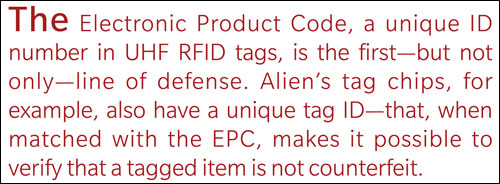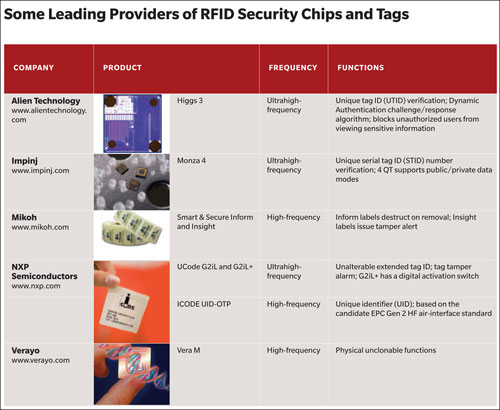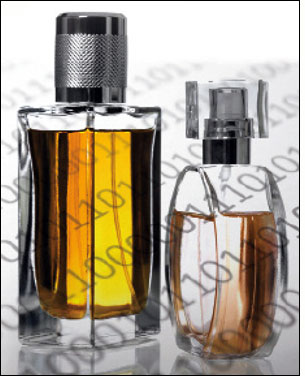Product counterfeiting has long plagued manufacturers in many industries, and from all accounts, the problem is growing worse. That’s due, in large part, to more outsourcing of manufacturing in Asia and booming online sales.
“Faking things is kind of a national sport in China,” says James M. Bevan, the managing director of research firm Vandagraf International. “Then you throw in the Internet sales of products [on sites] you Google up for Gucci handbags, and what you actually get are China fakes. Put the Internet and outsourcing to China together, and the [number] of counterfeits absolutely skyrockets.”
|
|
In addition, supply-chain diversions to unauthorized outfits cost companies worldwide billions of dollars in lost revenue. Product-related crime losses, including counterfeiting and gray-market diversions, amounted to nearly $700 billion in 2008, or about 7 percent of world trade, according to Vandagraf.
Several radio frequency identification technology providers have developed item-level security applications to address these problems, though few manufacturers and distributors have taken advantage of them. But that’s beginning to change, thanks to RFID chips and tags with enhanced data security features, lower prices, and more understanding among end users that RFID can be used to thwart counterfeiting and diversion.
“Four years ago, I could say with a fairly high level of confidence that zero tags were sold for this purpose, except possibly for experimental lab work and pilots,” says Scot Stelter, senior director of product marketing at Impinj. “Now, we are starting to see volume purchases of RFID tags for that application,” such as the tagging of high-value branded goods.
The use of passive RFID tags as a security technology rather than just a track-and-trace effort is growing about 17 percent annually, according to Vandagraf. “If you are an RFID chip manufacturer and say you could supply a passive RFID label that would meet track-and-trace needs and maybe antitheft needs and authentication all bundled in, then your sales offering becomes more powerful,” Bevan says.
What makes an RFID tag capable of securing goods against counterfeiting or providing forensics insight into unauthorized supply-chain diversions? Not surprisingly, vendors vary in their approach to these challenges. Consider the following issues when choosing an RFID solution to protect your brand and reduce theft. Then check the table on page 35 for specifics on some leading RFID vendors that make security chips and tags for your application.
Passive UHF vs. Passive HF
Most RFID security tags are passive, but whether you opt for ultrahigh-frequency (UHF) tags, which are compliant with the EPC Gen 2 standard, or high-frequency (HF) tags, typically ISO-compliant, will depend on what’s critical to your value chain. The EPC Gen 2 tag has become the standard RFID tag used in the retail supply chain, and EPC RFID tags are being used for supply chain track and trace in other industries as well. In the retail apparel sector, for example, the same tag could be used for inventory management and security applications. Passive UHF systems generally have a read range of 10 feet to 30 feet (3 meters to 9 meters), and some EPC Gen 2 tags are designed to work on or around metals and liquids.
HF tags, which work well around metals and liquids, have a shorter read range—up to 3 feet (1 meter). That makes them a good choice for the pharmaceuticals sector, where item-level tags must be read at close range. The coming wave of mobile phones equipped with Near-Field Communication (NFC)—an HF wireless technology that enables data exchange between two NFC devices—could make HF RFID more appealing at the retail level (see What Retailers Need to Know About NFC Payment Systems). Shoppers could use their phones to read items embedded with secure HF RFID tags to verify whether the items are real, says Tim Newsom, director of RFID sales and marketing at NXP Semiconductors. Using secure HF RFID to give shoppers access to special deals is another way companies can use the technology to add value to the customer experience, Newsom says.
How UHF Security Tags Work
The Electronic Product Code, a unique identification number in UHF RFID tags, is the first—but not only—line of defense. Impinj’s family of Monza 4 tag chips have a 32-bit EPC Gen 2 number and a unique serial tag ID (STID) number, which is hard-wired into the chip and cannot be changed. “Now you put the two numbers in the database so you can cross-reference them,” Stelter says. “If you want to find out if a particular item is counterfeited, you read its two numbers [the EPC and STID numbers], then go to the database and make sure those are the two numbers associated with each other. If so, it’s a legitimate item.”
But if the STID and EPC numbers don’t match, it points to a problem. Even if someone could replicate the STID number, Stelter contends, your database would still record the legitimate locales the chip had passed through—any chip with the same number showing up elsewhere would indicate trouble. “This addresses two things,” he says: “The notion that you can counterfeit an RFID chip with an STID number—anything can be done, but it becomes very expensive and daunting for the counterfeiter. And, in the end, the system still provides the ability to identify when something is counterfeited.”
The Monza 4 QT chip also has a set of features to restrict access to any business-sensitive or personal data stored on the tag. To protect the confidentially of the information encoded to a tag, the 4 QT chip supports two data modes: In “private” mode, designed for a company’s internal use, authorized individuals using a password-protected command from the interrogator can read all the data stored on the chip; in “public” mode, only a generic serial number can be read, so sensitive information remains under wraps.
This can be valuable for work-in-process requirements, especially in sensitive industries, such as custom textile manufacturing for high-fashion collections, where everything’s hush-hush until the clothes hit the catwalk. Flipping to private mode lets a manager access information about, say, next steps for the fabric weave, and flipping it back to public mode keeps that data from rank-and-file employees.
A “peek” feature ensures that a user who temporarily switches a public tag to private to access the information doesn’t inadvertently leave the tag in private mode, exposing confidential data to unauthorized users. When the chip loses power, it automatically reverts to public mode.
To view a larger version of the above chart, click here.
Alien Technology takes a similar approach with its Higgs 3 chip, which powers its EPC Gen 2 RFID tags. It includes a unique tag ID (UTID)—an additional factory-programmed, unalterable 64 bits—that, when matched with the EPC number, makes it possible to verify that a tagged item is not counterfeit. The chip also includes a security feature called Dynamic Authentication, which relies on a challenge/response algorithm—the tag’s signature is challenged by the reader for Higgs-3 authenticity and confirmed by the host for secure identification. And like the Monza 4 QT chip, the Higgs 3 includes a way to lock unauthorized users out of sensitive information. Alien is addressing market demand for more value by including these capabilities at the same cost as its earlier, Higgs 2 line, says Victor Vega, marketing director at Alien Technology.
NXP Semiconductors offers two passive UHF RFID chips—UCode G2iL and G2iL+—aimed at the fashion and electronics industries and other markets that require privacy, security and antitampering functions. Both chips have an integrated tamper alarm—a small wire connects two metal pins on the chip; if it breaks, as it might if someone tries to remove it from an authentic product with plans to reaffix it on a fake, an alert goes out, along with the tag’s ID number. The G2iL+ also incorporates a digital switch that could help thwart gray-market diversion of electronics. Manufacturers could hard-wire the chip to a microcontroller during assembly of an electronic device or appliance. The device would only work if the digital switch were activated by the retailer at the point of sale.
How HF Security Tags Work
Some HF RFID vendors also take a physical approach to anticounterfeiting. Verayo says the integrated circuits (ICs) in its Vera M series products are based on the company’s Physical Unclonable Functions (PUF). This technology exploits the unavoidable variations that occur in IC manufacturing—in other words, the physical characteristics of each chip are unique, which makes it possible to determine authenticity. It’s like a “digital fingerprint,” says Vivek Khandelwal, VP of marketing and business development at Verayo.
“When we manufacture a chip, we ‘talk’ to that chip on the wafer and ask how it was created, and collect some parameters from the chip,” he says. “We do it for every chip on the wafer, then encrypt that information and put it back on the chip itself.” Down the line, an RFID reader decrypts that “genetic code,” creates a random number challenge and calculates the response. Thereafter, it issues the same challenge to the chip, and compares the chip’s response with its own response to prove authenticity.
Mikoh takes a different physical approach with the tamper-evident technology in its Smart & Secure HF lines. The company’s Inform (also known as Destruct-on-Removal) pressure-sensitive RFID label disables RFID functionality if someone tries to remove it from a legitimate device, possibly with the aim of moving it to a counterfeit item. The idea: If the tag is functioning, the asset to which it’s attached is real; if it’s disabled and unreadable, you may be dealing with a fake.
“What if a seemingly authentic tag is moved from one product to another?”asks Neil Mitchell, VP of marketing at Mikoh. “Generally, it can still be read. So we think the physical tampering of the tag is the most critical component. We ensure the authenticity of the tag so it can’t be cloned or copied, but in addition, our tags cannot be reallocated to counterfeit goods.”
The Insight version (also known as Tamper-Reporting) of Mikoh’s Smart & Secure doesn’t disable the RFID functionality if someone tries to make a switch, but instead alerts a reader that some sort of tampering took place, which could be cause for further investigation.
NXP also offers HF solutions for item-level RFID tracking, based on the proposed EPC Gen 2 HF air-interface standard. The company says its ICODE UID-OTP (one-time programmable) HF solution, for example, has applications for counterfeit protection of pharmaceuticals. The ICODE UID-OTP features an NXP-programmed Unique Identifier (UID) that guarantees the RFID tag is unique, and an OTP user memory that locks the data after programming. Pharmacies could run a query on tags that use the IC via a secure Internet connection to check tag data. As a final check, the technology detects in real time whether the EPC, in combination with the UID, is valid, which confirms the drug’s authenticity, the vendor says.
The new developments in RFID security tags provide a variety of approaches to help companies protect their products from those who’d like to counterfeit or divert them. “What you will need changes based on what market you are in,” says Vandagraf’s Bevan.
What Needs RFID Protection
Some manufacturers and distributors of the products listed below are using radio frequency identification security tags to guard against counterfeiting and supply chain diversion.
High-value consumer goods: These luxury products include jewelry, perfume and branded ladies’ handbags. The high-end fashion industry also suffers from both counterfeiting and supply-chain diversion. Italian apparel designer and manufacturer G&P Net, for example, experienced supply-chain leaks that led to its high-end garments winding up in cheaper outlets, diluting its brand. Now, G&P Net uses RFID as a forensics tool to help gain control over its distribution channel, says Victor Vega, marketing director at Alien Technology. (For more information, see RFID Targets Gray Market in Europe.)
Expensive liqueurs, spirits and wines: High-end producers of alcoholic beverages in Europe, the United States and China have to combat a growing trend toward counterfeit wines and spirits. Impinj is working with several customers in China, for example, that are considering using its Monza 4 QT tag, which has anti-counterfeiting features, to protect their brands. At least one company plans to take advantage of the tag’s securable user memory, which can store password-protected information related to the production of each bottle, says Scot Stelter, senior director of product marketing at Impinj.
Pharmaceuticals: California’s electronic-pedigree requirement for pharmaceuticals has been pushed back to 2015, but some highly counterfeited items are being tagged and tracked today to protect consumers. Nigeria’s National Agency for Food and Drug Administration and Control has approved the use of an RFID system designed by Verayo and SkyeTek and marketed by GlobalPCCS to authenticate pharmaceuticals to combat counterfeiters, and to generally safeguard the quality of medications sold in that country. (For more information, see Nigerian Drug Agency Opts for RFID Anticounterfeiting Technology.)
There’s also potential for RFID to be deployed as an anticounterfeiting or antisupply-chain diversion technology in other sectors, says James M. Bevan, managing director of research firm Vandagraf International. Chinese factories, for example, are manufacturing low-quality automotive tires and selling them as Firestones and Michelins. There’s a lot of that going on, he says. And that’s bad news for the real high-quality tire manufacturers that built their reputations on reliability and safety.
In the electronic components and products markets, circuit boards often originate in counterfeit-friendly Asia, Bevan says. The aerospace and defense industry could tag aircraft parts, to ensure counterfeit parts don’t compromise performance and safety. And the tobacco sector could benefit from tracking expensive cigars, he adds.





